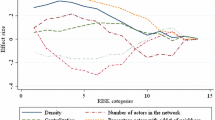Abstract.
We study a setting in which individual players choose their partners as well as a mode of behavior in 2×2 anti-coordination games – games where a player’s best response is to choose an action unlike that of her partner. We characterize the equilibrium networks as well as study the effects of network structure on individual behavior. Our analysis shows that both network architecture and induced behavior crucially depend on the value of the cost of forming links. In general, equilibrium configurations are found to be neither unique nor efficient.
Similar content being viewed by others
Author information
Authors and Affiliations
Corresponding author
Additional information
We acknowledge financial support from Instituto Valenciano de Investigaciones Económicas and the Spanish Government through the grant no. BEC 2001-0980. We thank an associate editor and two anonymous referees of this journal for helpful comments. We are also grateful to Juan D. Moreno-Ternero for suggestions.
Rights and permissions
About this article
Cite this article
Bramoullé, Y., López-Pintado, D., Goyal, S. et al. Network formation and anti-coordination games. Int J Game Theory 33, 1–19 (2004). https://doi.org/10.1007/s001820400178
Issue Date:
DOI: https://doi.org/10.1007/s001820400178




